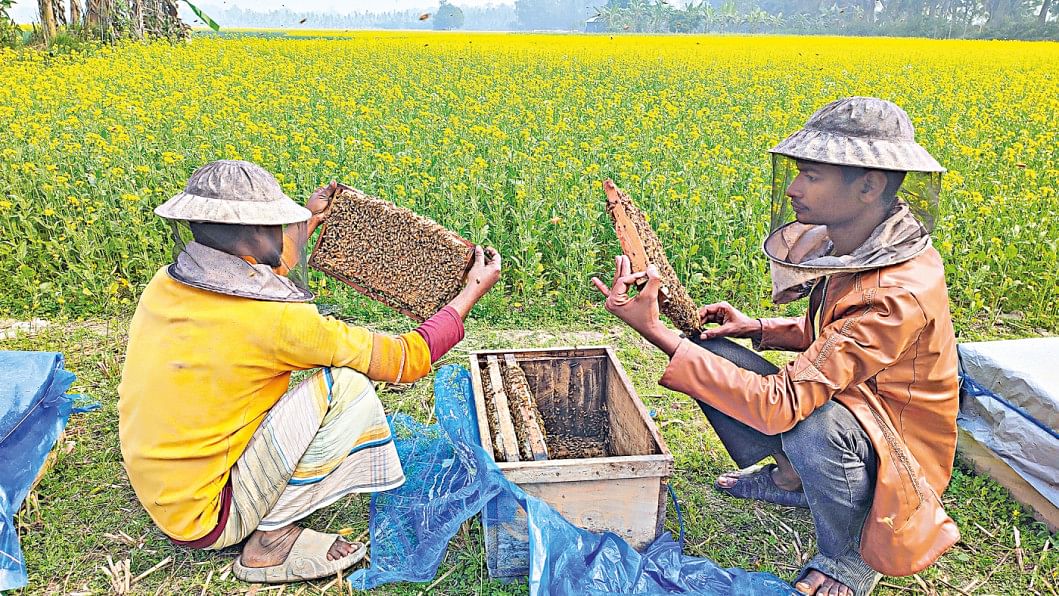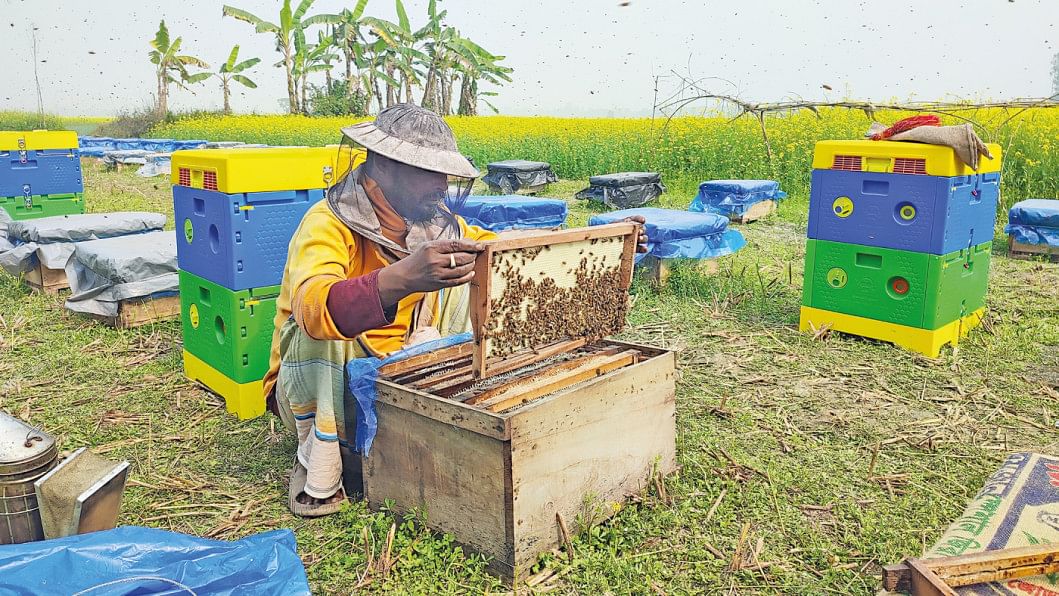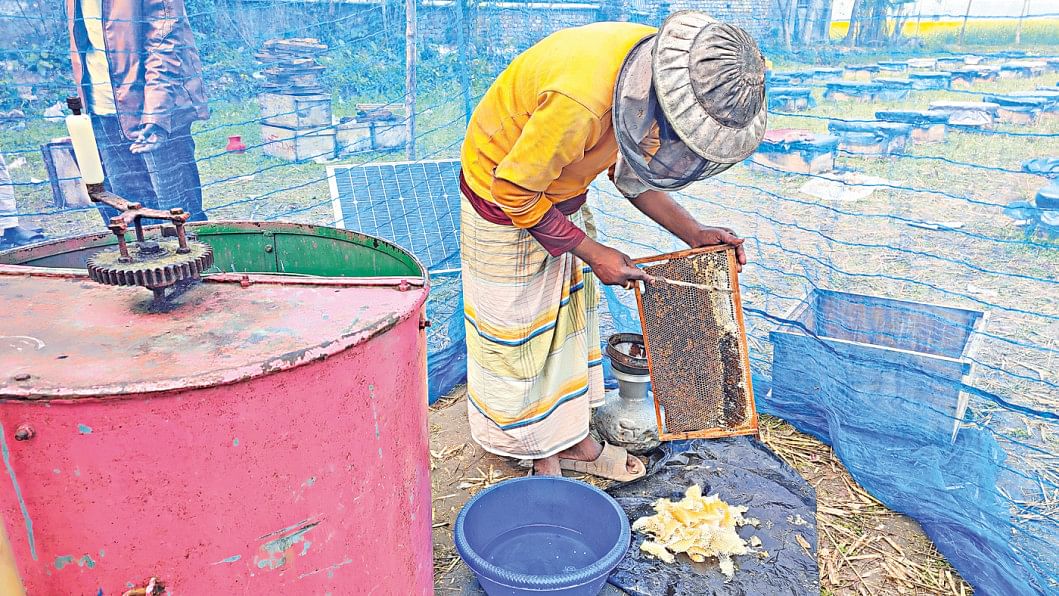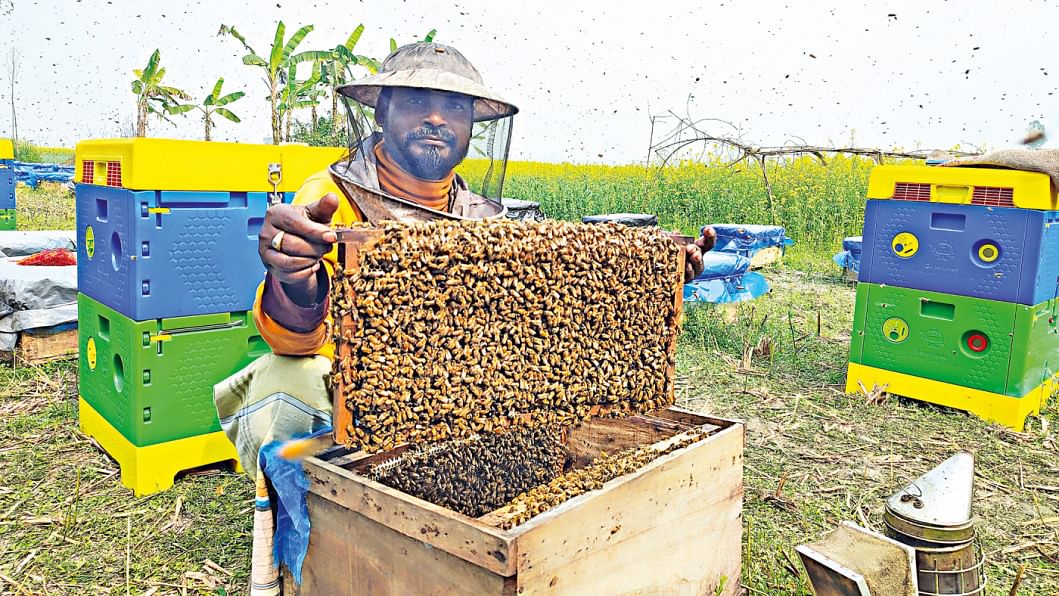Bees & bucks: Beekeeping boosts rural incomes
From December to February, mustard fields across Bangladesh become buzzing ecosystems as bees, both wild and domesticated, diligently go from flower to flower in search of their most precious commodity: nectar.
This nectar is used by bees to create honey, which fuels livelihoods, contributes to the local economy, and supports agricultural pollination, increasing farmers' production by up to 15 percent.
Although the task is labour-intensive, beekeeping offers rural communities a sustainable source of income, with the demand for honey continuing to rise both locally and internationally.
However, this promising industry is not without its challenges, with beekeepers forced to combat uncertain weather and continuously learn about the ecological importance of bees.
Districts such as Sirajganj, Pabna, Rajshahi, Thakurgaon, Dinajpur, Panchagarh, Satkhira, Khulna, Bogura, Naogaon, Magura, Sylhet, Tangail, Mymensingh and Chattogram have become potential business hubs for honey, centring around mustard, black cumin, litchi, mango, sunflower, olive, Indian jujube (plum), and much more.
A large number of rural farmers and beekeepers are directly involved in honey production, with estimates ranging from 10,000 to 20,000 individuals.
However, when considering all the people involved in honey production and marketing across different stages of the supply chain, the estimated number climbs to 90,000.
According to reports and various agricultural surveys, Bangladesh produces an estimated 30,000 to 40,000 tonnes of honey annually.
A majority is wild honey, which comes from the Sundarbans, but there are a few structured beekeeping practices in rural and semi-urban areas.
The total honey consumption in Bangladesh is estimated to be around 25,000 to 30,000 tonnes annually, with urban areas (especially Dhaka) consuming a larger share due to the growing health-conscious population.
On average, per capita consumption of honey in Bangladesh remains relatively low, at around 100 grammes per person per year, which is much lower than in Western countries.

The consumption is expected to rise by approximately 5-10 percent per year, driven by urbanisation, increased health awareness and a shift toward natural sweeteners.
According to the Department of Agriculture, the target for mustard cultivation in the country has been set at 1,164,576 hectares for the fiscal year 2024-25, with around 125,171 hectares dedicated to honey cultivation.
Bees are particularly fond of mustard flowers, not only because they are abundant sources of pollen and nectar, but also because the nectar from mustard flowers is easy for bees to access.
This year, 93,478 bee boxes have been installed and experts estimate that over 1.5 million kilogrammes (kgs) of honey may be harvested.
Shahadat Hossain, a former handloom factory worker from Garudaha, Sirajganj, switched to beekeeping after the Covid-19 pandemic and found success.
Now, his seasonal work revolves around mustard plants, mango orchards and litchi gardens.
Known in his locality as "Modhu Shahadat", the 58-year-old sets up his bee boxes in mustard fields every year. Each box houses a colony, including a queen bee and around 800 to 1,200 worker bees.
Shahadat explains that the queen is crucial, laying eggs and producing pheromones that regulate the hive. The bees leave through a gate called the "Queen Gate" to collect nectar, creating a fascinating, buzzing atmosphere.
He monitors the bees' activities closely, moving every eight days to new mustard fields and staying in a temporary tent while working.
Last week, he harvested 65 kgs of honey, but it fell to only 37 kgs this week due to chilly weather.
Shahadat sells his produce for Tk 350-400 per kg and earns between Tk 5 lakh and Tk 7 lakh per season.
He has invested in land to increase output, purchasing 24 decimals in his village.
"I had no home of my own, so I used to live with my father-in-law at Kalidasgati for so long. Now I have bought 24 decimals of land in my village, Garudaha, where I plan to build my dream home," he said.
Many customers, like Mehedy Hasan Murad from Gandail, often miss out on Shahadat's honey, which sells out quickly.
Looking ahead, Shahadat plans to move to a char area on the eastern banks of the Jamuna River for the remainder of the season and later travel to the Thakurgaon and Dinajpur areas for litchi honey. He has already contacted litchi garden owners to secure his next source of honey.

Another area that plays a crucial role in Bangladesh's honey production is Sirajganj, an area with fertile agricultural land and mustard fields dotting the landscape.
AZM Ahasan Shahid Sarker, deputy director of the Department of Agriculture Extension (DAE) in Sirajganj, reveals that mustard cultivation in the district has expanded to 87,125 hectares this year, surpassing last year's 85,170 hectares.
"BARI 14, a high-yielding mustard variety, is the most common choice among farmers. This variety's ability to thrive in the local soil has made it particularly popular," he says.
The increase in mustard cultivation has led to an expected honey harvest of 400 tonnes this year, a modest increase from the 382 tonnes collected last year.
However, beekeeping is far from easy work. Long hours, harsh weather, and seasonal uncertainties make it a challenging profession.
Like the Bangladesh Small and Cottage Industries Corporation (BSCIC), the DAE offers training to aspiring beekeepers. With continued education, support, and better awareness, the future of beekeeping in Bangladesh looks promising.
However, despite the rewarding nature of the job, easier access to learning materials and growing demand for honey, beekeepers face several challenges.
One primary issue is a lack of awareness among farmers.
Saidee Rahman, an agricultural extension officer in Sirajganj, mentions that many farmers still view bees as a threat to crops despite the clear benefits of pollination.
"People still believe bees harm their crops, but the truth is that bee pollination can actually increase crop yield by 15 percent," he explains.
Training and awareness campaigns are crucial to dispelling these misconceptions and encouraging more farmers to embrace beekeeping and the role bees play in crop production.
Pabna is another major hub for honey production from mustard flowers. The district's Sujanagar upazila is home to beekeeper Md Oli Pramanik, who has been involved in honey collection for the past 15 years.
He manages 400 bee boxes with the help of his family members, working year-round to care for the bees, repair boxes, and extract honey.
In January, Oli set up 125 bee boxes in a mustard field, expecting to extract between 800 kgs and 1,000 kgs of honey by month's end.
"Each bee box produces around 2.5 to 3 kgs of honey within a 10-day cycle," he says, explaining that when bee boxes are set up in mustard fields, he must wait at least 10 days for the bees to gather nectar.
"If the expected honey yield isn't met, we move the boxes to another field," he says.
Like Shahadat, Pramanik works with multiple fields and crops throughout the year. After extracting honey from mustard fields, he moves to other winter crops and eventually to litchi orchards in the summer.
His family has worked as beekeepers for generations and they are now experts in the field.

"December to April is the prime time for honey collection. We start honey collection from mustard fields from December to February and finish in litchi orchards from March to April,"says Md Sirajul Islam, Pramanik's son.
"During the rainy season, there's no work, so we focus on nursing the bees and repairing the boxes for the next season."
The potential for expanding beekeeping in Bangladesh is immense given the country's favorable conditions, including a variety of plants, the availability of different honeybee species, and an increasing demand for related products.
According to MA Hossain, director general of the Bangladesh Sugarcrop Research Institute, and SK Pal, director (research), beekeeping is an industry with low investment and high profitability.
They also highlight the unique opportunity that beekeeping presents for rural development, with products ranging from honey to beeswax.
"The demand for sustainable beekeeping is increasing due to high-quality products and the opportunity for rural growth," they state in their research, styled "Beekeeping in Bangladesh - Status and Prospect."
The honey production industry has shown growth over the last decade, driven by increasing interest in beekeeping and a greater focus on organic farming. Many people have launched online businesses based on honey, earning their livelihoods through this growing sector.
As the demand for honey continues to rise, corporate houses are also recognising the potential of this market.
Companies like ACI Limited have ventured into honey production, focusing on multifloral varieties, including mustard, litchi, and black cumin.
Md Saiful Islam Imran, brand manager for consumer brands marketing at ACI, notes that despite initial challenges with mustard flower honey production, the company has seen growing demand for its products nationwide.
"We are now available in e-commerce, modern trade, and retail sales, and our product is reaching every district in Bangladesh," he says.
Honey production in Bangladesh is not limited to mustard fields alone. Other areas, such as the Sundarbans, produce honey from various sources.
Amina Khatun, manager of the development division at the BSCIC, notes that beekeepers exceeded expectations by harvesting 7,449.40 tonnes of honey last year, surpassing the projected 7,000 tonnes.
"Honey production largely depends on the weather. A good season yields more honey, and with favorable conditions, we expect even greater yields in the future," she says.
As the industry grows, the BSCIC plays a key role in training new beekeepers, offering courses, and providing hands-on training for 480 individuals every year.
"After completing the training, we provide each trainee with a couple of bee boxes to help them get started," Amina says.
Historically, Satkhira and Khulna were the traditional hubs for honey production in the country.
Today, honey from the Sundarbans continues to gain popularity, especially Khalisha flower honey, which is considered the highest quality variety in Bangladesh.
A significant amount of honey is also produced from mustard flowers in the region.
Md Saiful Islam, deputy director of the DAE in Satkhira, mentioned that the target for this year was to produce 75 tonnes of mustard flower honey.
However, due to waterlogging, many farmers in certain areas could not cultivate mustard plants, affecting the target.
"So far, we have received information about 21 tonnes of honey. I will be able to provide the final amount once I receive the report from our district field officers next week," he said.

"The amount will likely not exceed 50-55 tonnes," he added.
Plaboni Sarker, additional agriculture officer in Satkhira Sadar Thana, informed that mustard has been cultivated on 6,000 hectares in the sadar upazila, with an estimated production of 16,125 kgs of honey -- 20 percent more than last year.
There are 15 beekeepers in the area working under different firms, who have set up 2,960 bee boxes, up from 2,643 boxes last year.
Mustard cultivation is also thriving in Magura.
Md Yeasin Ali, deputy director of the DAE in Magura, reported that mustard has been cultivated on 22,862 hectares this year, an increase from 22,211 hectares last year.
"Around 144 beekeepers have set up 7,895 bee boxes to produce honey. They have collected 27.5 tonnes of honey, which is a 49 percent increase compared to last year," Ali said.
Honey is also produced from mustard flowers in Bogura. Md Motlubar Rahman, deputy director of the Bogura DAE, stated that mustard has been cultivated on 37,500 hectares in the district.
He has also visited the Dupchachia, Sherpur and Dhunat upazilas, where beekeepers are especially active.
However, all these individuals are aware that the path ahead will not be easy.
Beekeepers like Shahadat, Oli, and others face constant challenges, from weather and resources to the physical demands of their work.
This is most pronounced during the off-season, when honey collection is minimal. During this time, beekeepers must feed their bees to keep them healthy and productive.
Shahadat shares that feeding his bees sugar during the lull can cost anywhere between Tk 50,000 to Tk 75,000, as each bee box requires one kg of sugar per week.
Another challenge for beekeepers is managing queen bees. When queen bees become old or sick, the whole colony suffers.
Moreover, although production is growing, honey exports remain limited. The country exports only a small portion, estimated at a few hundred tonnes per year, with quality and standardisation issues posing the biggest obstacles to large-scale export growth.
If these issues can be adequately addressed with continued support, education, and resources, beekeepers may overcome challenges and help the honey industry in Bangladesh meet its immense potential.


 For all latest news, follow The Daily Star's Google News channel.
For all latest news, follow The Daily Star's Google News channel. 







Comments